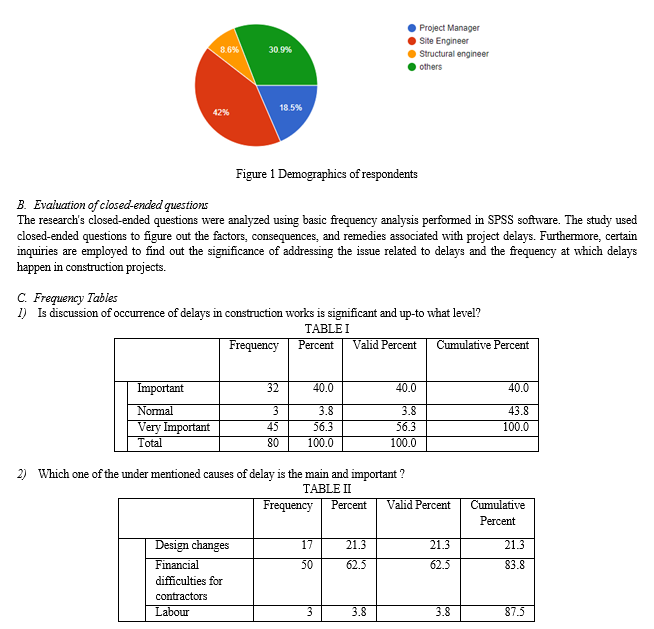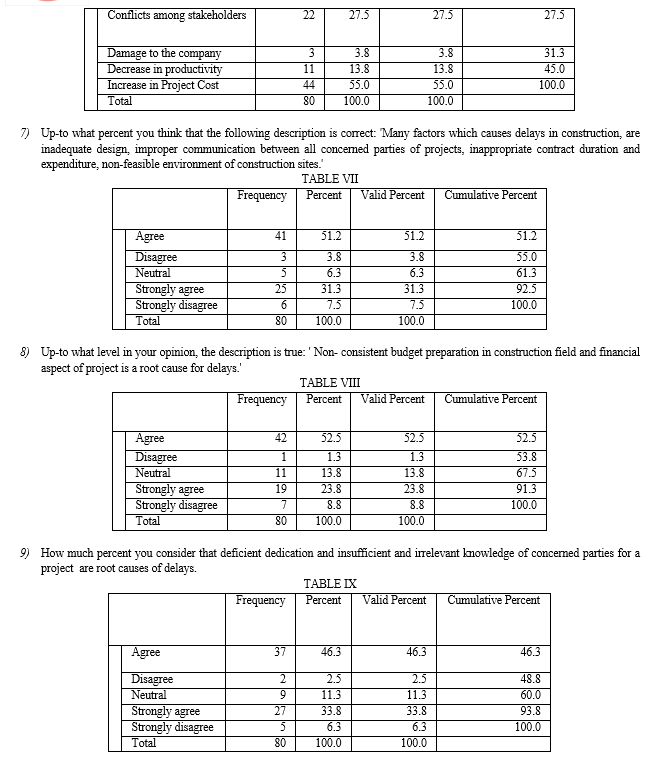Ijraset Journal For Research in Applied Science and Engineering Technology
- Home / Ijraset
- On This Page
- Abstract
- Introduction
- Conclusion
- References
- Copyright
Causes of Delays in Construction Projects in Peshawar Region and It’s Preventive Measures
Authors: Muhammad Afzaal, Shahid Ullah
DOI Link: https://doi.org/10.22214/ijraset.2023.55960
Certificate: View Certificate
Abstract
Construction delays means that tasks are finished later than expected time or required by contract. Finding the source of construction delays is crucial to reducing them. This study tries to identify the major causes for project delays and typical remedies in Peshawar region, Pakistan\'s construction industry. Additionally, by correlating the criteria found in the literature review with perceptions from construction specialists working in Peshawar region, Pakistan. This research confirms the validity of the factors found there. This study was carried out utilizing a combination of evaluating previous research and conducting a questionnaire-based survey. To collect opinions from a range of construction professionals, including clients, contractors, and consultants, the survey questions were purposefully designed to include both open-ended and close-ended forms. These questionnaires were distributed to a number of people working in the construction business. The primary factors contributing to delays were mostly associated with financial challenges, including the slowness in receiving progress payments from project owners and difficulties contractors encountered in obtaining project financing. In addition to these difficulties, the study determined that cost overruns were the main effects of these delays. Notably, the study also identified effective communication as the most important aspect of controlling project delays. This study will help to improve business procedures and lessen the negative effects of construction delays in addition to offering helpful information to legislators, the individuals who hold decision-making authority, as well as other relevant parties involved in the construction sector.
Introduction
I. INTRODUCTION
Around the world, the construction industry has been dealing with criticism for causing delays, which have a harmful impact on the progress of construction projects. Construction delay are defined as an act or event which lengthens the specified period for completion of the project. In Pakistan, the construction sector has drawn its share of criticisms from government bodies, construction experts, and academics. The issue of delayed construction projects refers to instances where the completion time exceeds the predetermined limits. This can stem from the inability to finish a project within the specified timeframe due to various factors. Such delays can have significant consequences, leading to economic growth setbacks for businesses, companies, and organizations. These impacts encompass reduced production, escalated expenses, diminished facilities, and constrained business scopes. Consequently, the delay in construction poses a substantial threat to project owners.
Discussing and gaining information about the reasons behind construction delays can aid in pinpointing key contributors and assessing their importance, aiming to mitigate the repercussions of project delays. This study centres on an investigation that encompasses an assessment of delay challenges encountered by construction projects in Peshawar, Pakistan. Through this assessment, the objective is to comprehend the essence of these delays and their primary drivers that impact the construction industry. Furthermore, the study aims to identify optimal strategies for mitigation, thereby reducing the occurrence of project delays. The research holds significance in its exploration of how owners and project managers impact the efficacy of construction project execution. This exploration offers valuable insights for managing factors influencing project timelines. Another crucial aspect of this study involves analyzing delay factors and devising optimal solutions to address them, thereby promoting the advantages of eradicating delays in Peshawar's construction industry, Pakistan. This research also carries weight in consolidating recommendations and data necessary for mitigating challenges arising from delay-related risks. Additionally, the study's discoveries will furnish guidance to enhance the overall performance of construction project.
II. LITERATURE REVIEW
The most significant challenge encountered within the construction industry is universally acknowledged to be project delays.
These delays not only result in a departure from the initially committed project completion timeline, but they also give rise to various other complexities. These include unanticipated modifications to plans due to scheduling shifts, operational constraints within the company, diminished workforce efficiency, and unwarranted expenditures. The emergence of these complications can be attributed to a multitude of factors inherent in the intricacies of construction, and even to the influence of existing literature. In reality, the role of literature in the construction sector is of paramount importance, intricately tied to tasks such as designing building structures, documentation, maintaining comprehensive records of systems and contracts, and handling legal documentation related to construction sites. Any disruption in the literary aspects, regardless of nature, holds the potential to trigger project delays and give rise to concerns surrounding property legality. Instances such as mismanaged administration leading to inaccuracies in contract duration, design errors in buildings incurring substantial financial losses, and inadequate project planning and staff oversight contributing to delays, underscore the criticality of literature. Furthermore, the meticulous documentation of tasks and accomplishments significantly contributes to effective time management. In the absence of such records, the aftermath includes delays due to inadequate measures during accelerated work, wastage, interruptions, and other related issues etc.
A series of tests were done on construction projects in Wales, which revealed many reasons contributing to construction delays. These factors encompassed deficiencies in project design, social and environmental influences, project dimensions, and project variety . Moreover, the study identified a total of 19 factors contributing to delays in various projects. Among these factors, waiting for information, variation orders, and ground difficulties were shown to be the most significant. In the same way, conducted an analytical investigation and arrived at the same findings regarding the factors contributing to construction delays. These factors include fluctuations in climate, unforeseen geological conditions, market competition, decreased adaptability among contract stakeholders, labor inefficiency, financial issues, and flawed designs. However, experiments that proves that key reasons of delays in construction tasks are inaccurate budgeting, inadequate consideration of effectiveness difficulties, resource depletion or financial constraints, unpredictable market value fluctuations, and improper procedures and management. In a study conducted by, it was shown that inadequate budgeting processes, underestimation of project complexities, financial challenges, discrepancies in material costs, and ineffective site management practices frequently contribute to project delays in the construction industry.
Based on the findings of a survey conducted in a research, it has been determined that several variables contribute significantly to construction delays. These factors include engineering design issues, climate variations, budget overruns, and changes in project tools and equipment. A comprehensive assessment of 19 studies, which included an examination of the reasons of delays on a global scale. However, existing literature suggests that there is a lack of empirical research specifically focused on the factors contributing to project delays within the construction sector in the twenty-first century. According to a recent survey conducted in the residential building industry, there are problems with site management, ineffective communication methods, and a general lack of coordination. Certain variables have a significant magnitude that exerts a worldwide influence on markets and businesses. Construction delays are one such element that disrupts both national and international firms. the construction sector has seen heightened levels of hazard and increased uncertainty in comparison to other industries. This issue is deeply intertwined with the civil sector of engineering, as it pertains to the development of sites and structures. It is worth noting that this problem often remains unsolved and protracted throughout the duration of the project.
III. RESEARCH METHODOLOGY
A mixed methodology refers to the integration of qualitative and quantitative research approaches, which is favored due to its ability to enhance, investigate, and analyze data in a more efficient and improved manner. The primary emphasis of the research work will be based on a list of questions that will be served to the diverse construction experts employed within the construction sector of Pakistan. In addition, this portion further addresses the methods that will be employed to analyze and assess the data that has been acquired. This chapter is structured into several sections that provide a concise overview of the information and processes employed to accomplish the primary goals of this research work.
A. Research Approach
In order to achieve the aims of the study, the author employed a combination of qualitative and quantitative methodologies. Quantitative and qualitative research procedures are mutually supportive approaches that simultaneously contribute to the generation of comprehensive and multidimensional results. Irrespective of the specific objectives of a study, researchers currently possess a greater number of options and an abundance of qualitative and quantitative methodologies to design projects that generate more valuable insights.
The internet, often known as the World Wide Web, is a global network of interconnected computers that allows for the sharing and accessing of One of the key advantages of mixed methods research is its ability to provide researchers with the opportunity to develop objective information that can be represented through figures and statistics. The study employed a mixed methods approach to systematically collect and analyze data in order to identify relationships between variables. The integration of qualitative and quantitative data in an evaluation can enhance its effectiveness by effectively addressing the limits inherent in one kind of data through the utilization of the strengths offered by the other form.
B. Secondary analysis
In the chapter before, a secondary evaluation was conducted by utilizing research articles from journals, conference papers, samples from relevant theses, online surveys, and books on construction management. To conduct the article search, the databases of Google Scholar and Web of Science were utilized. Project delays, construction delays, causes, mitigation tactics, improvement strategies, and coping strategies were all used to locate relevant papers on the topic of delay. Through a comprehensive examination of scholarly articles, an overview of factors has been established that exerted an influence on the time frame of construction operations. Furthermore, an analysis has shown the primary causes of construction delays, along with an assessment of the impact of each delay on various construction operations. In addition, some fundamental remedies and mitigation techniques were identified that are widely implemented to mitigate the impact of delay's effects on deadlines for projects.
C. Designing a Questionnaire
In a number of research, it is commonly recommended that the design of the questionnaire aligns with the study objectives. The present study employed a similar methodology as previously indicated, with the primary objective being the identification of factors contributing to delays in the construction industry and the subsequent establishment of mitigation solutions. This was accomplished through the administration of a close-ended questionnaire to validate the findings. Furthermore, the research focused on specific objectives relevant to the actions undertaken by the project stakeholders that contribute to project delays, as well as the strategies for mitigating these delays by selecting the most effective suggested methods. The questionnaire consisted of a combination of open-ended and closed-ended questions. The closed-ended questions were formulated based on the identified delay factors and their related remedies. On the other hand, the open-ended questions were designed to gather comprehensive opinions from construction experts regarding this research. The purpose of this questionnaire survey was to gather the perspectives of a significant number of construction professionals regarding construction delays and the strategies that have been established to mitigate them. The survey investigated further into how delays affect project performance and looked at innovative methods to lessen their negative consequences.
D. Methodology used for gathering data
The survey data was collected from a group of participants who possessed sufficient knowledge and experience in construction projects within the Peshawar region, enabling them to provide insights on the research problem. Managers of projects, site managers, engineering designers, technical consultants, architects, and officials are only few of the groups whose perspectives are represented in the survey results. The selection of potential construction companies in Peshawar, Pakistan was conducted by a random sampling procedure. In order to get data, the investigators employ an inspection survey that is aligned with the mixed methods study strategy. The survey would include a combination of closed-ended and open-ended questions. A questionnaire is a research instrument comprising a set of inquiries employed to gather data from participants via qualitative inquiry or quantitative investigation.
E. Survey analysis technique
Various types of ranked analysis are provided and discussed within the context of survey data analysis. In the context of data analysis, several processes are employed for the study of close-ended and open-ended questions. For open-ended questions, a simple thematic analysis approach was utilized to extract significant data, which was subsequently subjected to discussion and explanation. However, with regards to closed-ended questions, a basic frequency analysis was conducted using SPSS software, and subsequent discussions were held for each topic.
In addition, the data was tested using both Excel software and SPSS to generate visual representations such as figures, charts, and pie charts, as elaborated in the forthcoming section on results and debates.
IV. RESULTS AND DISCUSSION
A. Analysis of Data
A total of 80 online surveys were distributed. The purpose of the questions was to gather data from respondents regarding their professional roles, namely in the fields of project management, civil engineering (site and structural), and other associated positions within the civil industry, such as surveyors, inspectors, contractors, and consultants. The analysis of the respondents' demographics revealed that 42 percent of the individuals in the entire sample size were civil (site) engineers, while 18.5 percent were project managers and 30 percent were employed in other consultant roles.




V. ACKNOWLEDGMENT
I, Muhammad Afzaal, want to express my gratitude to Allah Almighty for providing me with the motivation and fortitude to finish this study. Prof. Dr. Bazid Khan., who has served as my adviser, has been very helpful to me. The prayers and encouragement of my parents also deserve recognition. In addition, I would to express my deep appreciation to the distinguished members of the CECOS university, Peshawar, Pakistan’s faculty and administration for providing the essential technical inputs, help, and resources required to complete this thesis. I would also like to thank my co author Shahid Ullah from University of engineering and technology, Taxila, Haripur, KPK, Pakistan.
Conclusion
The primary aim of this research, established at the start of the project, was to identify the primary factors contributing to delays and explore potential solutions via an examination of existing literature. Two additional objectives were achieved by conducting a questionnaire survey that was specifically developed to assess the expertise of construction firms in Peshawar, Pakistan. The responses obtained from these companies had a crucial role in influencing the outcomes of this study. According to the study results, financial concerns were identified as the primary reason of delays, accounting for 62 percent of the total factors investigated. Additionally, it was found that 55% of the participants agreed that cultural issues, such as tribal influence, were the primary contributors to construction delays. These delays may also arise as a result of holidays associated with certain religious festivals. In the same way, the findings from the open-ended questions indicate that financial concerns are the primary factor contributing to delays in construction tasks, whereas the scarcity of skilled labor ranks lowest among the identified reasons of delays. Furthermore, the findings of the research further support the concept that timely issuance of funds along with efficient communication helps mitigate project delays, as shown by responses to the open-ended question. Interestingly, the participants ranked the adoption of technology as the least favored strategy for addressing delays. Furthermore, it was determined by 55 percent of the participants that project delays led to cost overruns or increased project costs. Since everyone involved in the study agreed on the identified causes, preventive measures, and consequences of the delays, outcomes verify the analysis presented in the literature review. The study successfully accomplished all of its goals by using the aforementioned research technique. The results of the study have the potential to assist government officials, construction professionals, and experts in developing recommendations that may effectively mitigate project delays.
References
[1] Agyekum-mensah, G., & Knight, A. D. (2016). The professionals ’ perspective on the causes of project delay in the construction industry. 1997. https://doi.org/10.1108/ECAM-03-2016-0085 [2] Ahmed, S. (2020). 5 Key Ways To Minimise Delays In Construction Projects. https://www.cornerstoneprojects.co.uk/blog/minimising-delays-in-construction/ [3] Anderson, Z. (2018). The top 10 universal delay factors in construction projects. May. https://doi.org/10.1108/IJMPB-05-2017-0052 [4] Aziz, R. F., & Abdel-Hakam, A. A. (2016). Exploring delay causes of road construction projects in Egypt. Alexandria Engineering Journal, 55(2), 1515–1539. https://doi.org/10.1016/j.aej.2016.03.006 [5] Huang, Y., He, F., Morelli, N., & Heebner, N. R. (2019). Managing Delays in Construction Projects Aiming at Cost Overrun Minimization Managing Delays in Construction Projects Aiming at Cost Overrun Minimization. https://doi.org/10.1088/1757-899X/603/3/032004 [6] John, S. (2017). How Can You Reduce Construction Delays? https://www.stevensec.com/blog/how-can-you-reduce-construction-delays [7] Kog, Y. C., & Ph, D. (2018). Major Construction Delay Factors in Portugal , the UK , and the US. 23(4), 1–8. https://doi.org/10.1061/(ASCE)SC.1943-5576.0000389. [8] Oke, A. E., Ibironke, O. T., & Bayegun, O. A. (2017). Appraisal of reward packages in construction firms: A case of quantity surveying firms in Nigeria. Journal of Engineering, Design and Technology, 15(6), 722–737. https://doi.org/10.1108/JEDT-04-2017-0037 [9] Perth, C. (2016). Methods Of Minimizing Delays Construction Essay. https://www.ukessays.com/essays/construction/methods-of-minimizing-delays-construction-essay.php [10] Rhodes, B. C. (2019). Construction industry?: statistics and policy. 01432, 1–16. [11] Sakubu, O. (2019). 5 Key Ways To Minimise Delays In Construction Projects. Https://Www.Cornerstoneprojects.Co.Uk/. https://www.cornerstoneprojects.co.uk/blog/minimising-delays-in-construction/ [12] Senouci, A., Ismail, A., & Eldin, N. (2016). Time Delay and Cost Overrun in Qatari Public Construction Projects. Procedia Engineering, 164(June), 368–375. https://doi.org/10.1016/j.proeng.2016.11.632 [13] Shahsavand, P. (2018). Causes of delays in construction industry and comparative delay analysis techniques with SCL protocol. 25(4), 497–533. https://doi.org/10.1108/ECAM-10-2016-0220 [14] Wright, C. (2018). How to Avoid Delays in Construction Projects: 7 Steps You Can Take. https://solutions.borderstates.com/how-to-avoid-delays-in-construction/
Copyright
Copyright © 2023 Muhammad Afzaal, Shahid Ullah. This is an open access article distributed under the Creative Commons Attribution License, which permits unrestricted use, distribution, and reproduction in any medium, provided the original work is properly cited.

Download Paper
Paper Id : IJRASET55960
Publish Date : 2023-09-30
ISSN : 2321-9653
Publisher Name : IJRASET
DOI Link : Click Here
 Submit Paper Online
Submit Paper Online

